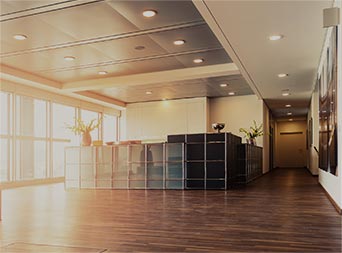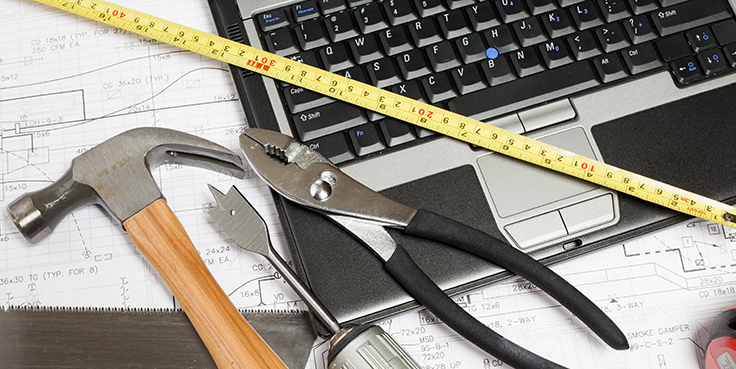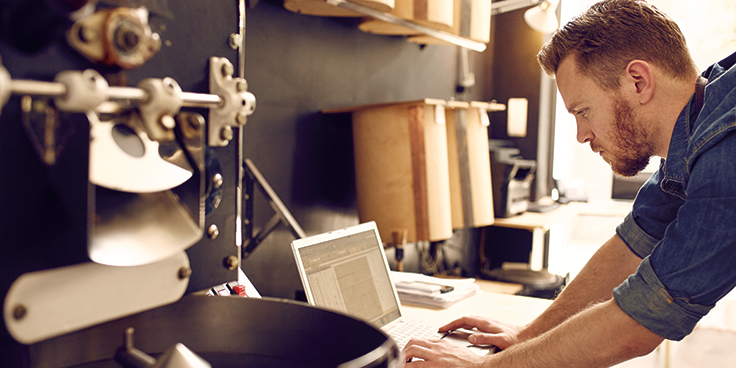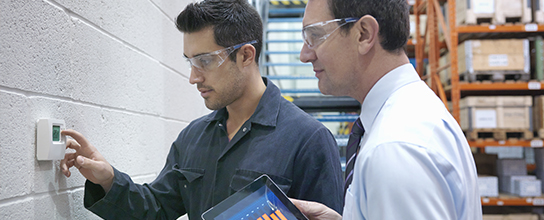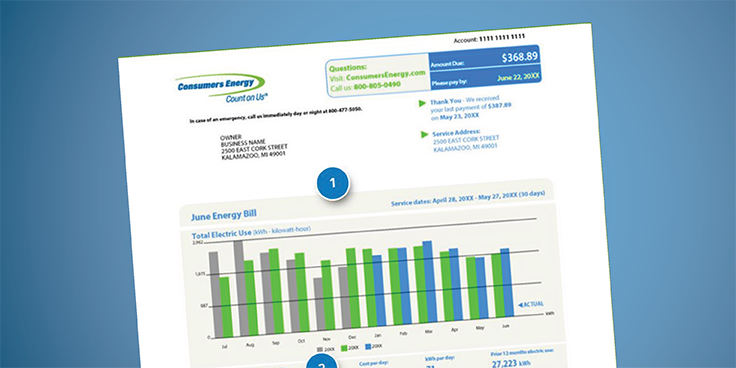Business Energy Efficiency Tips
80 Ways for Your Business to Save Energy
Save energy for your business with these simple low-cost and no-cost energy tips.
Lighting Tips
If your business is looking for ways to save money, you don’t have to look far for a solution. These illuminating suggestions won’t leave you in the dark.
- Turn off lights when not in use.
- Turn off outdoor lighting during the day.
- Use free “daylighting” to reduce need for artificial light. Adjust lighting to your facility’s actual needs.
- Clean windows and skylights regularly to let in more natural daylight.
- Make sure bulbs, fixtures, lenses and reflective surfaces are cleared regularly to increase the output of your lights.
- Replace any light bulb that burns more than one hour per day with a CFL or LED bulb.
- When buying bulbs, check the lumens. Higher lumens equals more light.
- Install occupancy and daylight sensors.
- Install ENERGY STAR® qualified exit signs.
- Consider painting the walls of your business in light colors. Since light bounces off walls and ceilings, you’ll get more light with lighter colors.
- Don’t over-light your facility. In addition to costing more, too much light can cause eyestrain, headaches and glare.
- Consider upgrading from T12 tubes to more efficient T8 fluorescent lamp tubes.
- Make sure your security lights are on a timer or photoelectric control so they turn on and off automatically as needed.
- When making new lighting purchases, look for products that are ENERGY STAR® qualified for the best energy savings.
Heating and Cooling Tips
Don’t sweat your energy bill. If you follow these suggestions, your business and your budget will be comfortable year-round.
- Have your HVAC system tuned up regularly. For best results, keep it tuned with a yearly maintenance contract.
- Replace (or clean) HVAC filters regularly.
- During cooling season, keep your thermostat set at 78-80° F when the building is occupied and 85° F when it is not. During heating season, set the thermostat at 68° F when the building is occupied and 55-60° when it is not.
- Keep furniture from blocking registers and vents.
- Inspect and repair worn or cracked caulking and weather stripping on all doors, windows and any areas where leaks could occur.
- Install drapes, shutters or window film to prevent unwanted heat loss and heat gain.
- Install a programmable thermostat to control your HVAC system more efficiently.
- Install and/or use locking devices on your thermostat to maintain efficient settings.
- In larger facilities with energy management systems, make sure temperature set points and operating schedules are correct for the controlled equipment.
- Use ceiling fans to keep the air moving. Ceiling fans can reduce energy use during both heating and cooling seasons.
- Don’t over-heat your facility. Use supplemental heating equipment for hard to-heat areas.
- Make sure your air conditioning unit is installed in a shady area.
- Don’t heat or cool unused areas. Close doors and vents to reduce energy use.
- Keep exterior windows and doors closed when HVAC is in use.
- When heating, close curtains, shades and blinds at night to retain heat.
- Repair old valves and steam traps.
- Consider tightening your building shell and adding insulation to reduce leaks.
- Consider installing energy recovery ventilation systems to reclaim waste energy from the exhaust air stream and use it to condition the incoming fresh air.
- Consider installing specifying economizers. These units draw in fresh air from the outside when the outside temperature is lower than the inside temperature.
- For facilities that have on-site heat generating processes such as cooking, consider heat recovery as a way to capture waste heat and use it to offset energy use.
- For areas such as warehouses, garages, waiting areas and patios, consider installing radiant heat. Radiant heat warms objects instead of the air, and uses less fuel and energy than traditional heating.
- Make sure all of your equipment is properly sized for your facility.
- Consider using a demand controlled ventilation system to meet the internal loads of your building.
- Install variable speed drives (VSDs) on large motor loads to reduce energy use.
- When replacing old motors, look for premium efficiency motors that operate at a lower annual cost. Make sure to get the proper sized motor for the application.
- When replacing your HVAC system, look for a highly efficient ENERGY STAR qualified system.
Kitchen Tips
Take some of the heat out of the kitchen with these suggestions to save you energy.
- Make sure there is room in front of your refrigerator/freezer to allow cold air to circulate better.
- Clean the condenser coils on your refrigerator at least twice per year.
- Make sure the condenser coils on your refrigerator are at least two inches away from the wall.
- Check to see if cold air is escaping around the door seal of your refrigerator. If it is, adjust or replace the seal.
- Service large refrigeration systems every year.
- Consider retrofitting existing refrigerators with anti-sweat door heater controls and variable speed evaporator fan motors and controls.
- Set the refrigerator thermometer at 38-42° F and your freezer at 0-5° F.
- Do not under or over-load your refrigerator or freezer.
- Separate your kitchen’s cooling equipment from your cooking equipment. This reduces the energy use of your refrigerator.
- If your business uses ice makers, make sure to choose a machine with the right amount of power and capacity for your facility.
- Make sure your oven doors fit tightly by adjusting door latches.
- Buy insulated cooking equipment whenever possible.
- Use insulated night covers on display cases.
- When making new kitchen equipment purchases, look for ENERGY STAR qualified product. This ensures that your kitchen is as energy efficient as possible.
Other Tips
Running your business already takes enough energy. Save some money by following these tips.
- Turn the water heater down to 120° F (if codes allow).
- Repair any leaky faucets or pipes promptly.
- Keep your hot water hot by making sure pipes in unheated areas are well insulated.
- Only use hot water when necessary.
- Consider installing water saving faucets.
- When buying a new water heater, buy the most efficient model possible. Look for the ENERGY STAR label to ensure savings.
- Unplug battery chargers when the batteries are fully charged.
- Plug electronic devices into an easy-to reach power strip and turn it off when the devices are not in use.
- Use the energy saving feature or sleep mode on office equipment that is not in use, when it is available.
- Turn off office equipment at night.
- When buying new computers, consider laptops rather than desktop models.
- Turn off computer monitors that are not in use, rather than using the screen saver.
- Install plug load controllers in cubicles to control multiple loads like monitors, task lights and fans. They use a motion sensor with a plug load surge suppressor, so equipment not in use can be shut down when the cubicle is unoccupied.
- Consider using ink-jet printers. They use 90% less energy than laser printers.
- Think about your facility’s actual needs when purchasing. Avoid purchasing more or less power and capacity than you need, especially when purchasing copiers.
- Encourage employees to use double-sided printing and copying whenever possible.
- Upgrade to energy efficient LCD computer monitors.
- When upgrading or buying new office equipment, always look for ENERGY STAR qualified products to ensure the best energy savings.
- Turn off the lights in your facility’s vending machines to reduce energy use.
- Place your vending machines in cool, shaded areas.
- Consider retrofitting your elevators with new, more efficient motors and drives.
- Train staff on proper maintenance procedures to ensure the most efficient use of office equipment.
- Encourage your employees to be aware of energy efficiency and to give their ideas of how energy can be saved at your facility.
- Consider forming an energy team at your business that will be responsible for discovering and pursuing energy efficiency opportunities at your facility.
- Compare your equipment’s efficiency ratings with the benchmarks available on www.energystar.gov to find your facility’s inefficiencies.
- Call Consumers Energy at 877-607-0737 to set up a free energy assessment of your facility, and let us help you find opportunities to save.
Explore Energy Efficiency Solutions for Your Business
Save even more with simple upgrades to your business. Check out our other programs below to see how we can work together to help you save.
For the best performance on this website and others, please upgrade your browser. For suggestions to find the best web browser for you click here.



